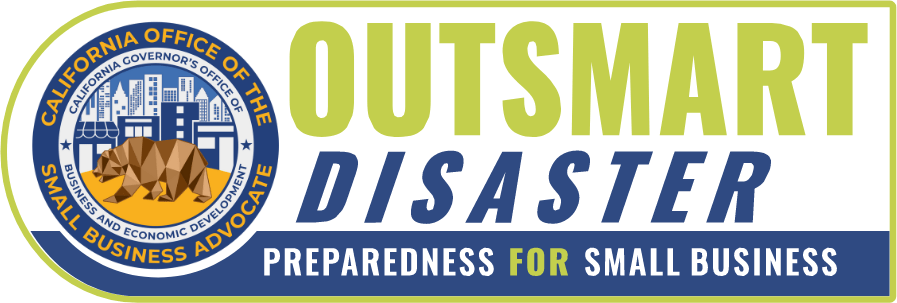Is your business prepared to Outsmart Disaster?
Disaster Preparedness & Resilience for Small Business Owners
Outsmart Disaster is a statewide campaign led by the California Office of the Small Business Advocate (CalOSBA) to raise awareness about the importance of preparing for disasters and emergencies. Outsmart Disaster provides California businesses and nonprofits with the training and resources needed to prepare for and recover from all types of business interruptions.
The Outsmart Disaster program is committed to helping small businesses become more resilient. When a business is resilient, this means they have the capacity to absorb stress, recover critical functionality, and thrive in altered circumstances. Our live webinar is now offered on the third Wednesday of each month. Join us to learn how your business can Outsmart Disaster.
If you are interested in building resiliency within your business and would like to learn more, download our Business Resiliency Roadmap to see how CalOSBA can help you Outsmart Disaster.
Por favor contáctenos a outsmartdisaster@gobiz.ca.gov para asistencia en español.
Business Resiliency Roadmap
Guide for small business owners that provides specific actions that they can take to develop their own Business Continuity Plan (BCP).
Outsmart Disaster 101
CalOSBA hosts monthly live training webinars. Join us to learn how your business can prepare to Outsmart Disaster.
Disaster Resources
The information and tools you need to prepare for and recover from a disaster or significant business interruption.
Who’s Behind Outsmart Disaster?
Outsmart Disaster is an initiative of CalOSBA supported by Coronavirus Aid, Relief and Economic Security (CARES) Act Recovery Assistance funds provided by the U.S. Economic Development Agency.
The Outsmart Disaster concept was originally conceived in 2018 as a state-led tool to help businesses and communities prepare for the next big earthquake. With the support of funders such as JP Morgan Chase Foundation and Edison International, and under the leadership of California’s Business Consumer Services and Housing Agency, the program evolved to help Californians prepare for all types of disasters. Now, with the support of approximately $782,000 in Coronavirus Aid, Relief and Economic Security (CARES) Act funding provided by U.S. Economic Development Agency and under the leadership of CalOSBA, Outsmart Disaster will further its work to help prepare Californians for the unexpected.
Disclaimer
Outsmart Disaster is a disaster awareness campaign that includes a no-cost business continuity training program offered by the California Office of the Small Business Advocate (CalOSBA). CalOSBA employees support the program in a training capacity only. CalOSBA does not make any recommendations or guarantees and assumes no responsibility concerning the activities of participating businesses. Participants, and not CalOSBA, are responsible for all plans created and any actions taken following the Outsmart Disaster training.
California Office of the Small Business Advocate
1325 J Street, Suite 1800
Sacramento, CA 95814
Speaker Request Form




